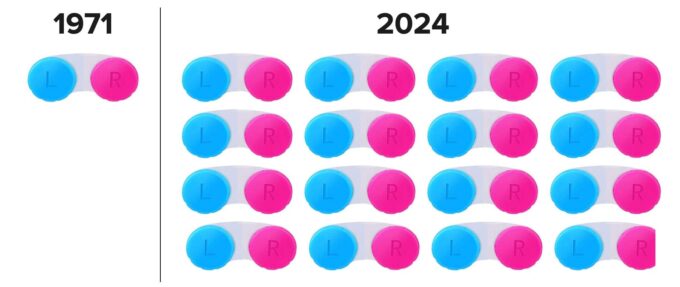Summary: Since the introduction of the first US commercial soft contact lenses, significant advancements have made them more accessible and affordable. This progress in abundance, driven by continuous innovation, underscores the importance of fostering an environment conducive to scientific and entrepreneurial advancements for the prosperity of society.
In 1971, Bausch & Lomb manufactured the first US commercial soft contact lenses. An eye doctor fitting ran around $550, and a pair of contact lenses cost $65, putting total costs around $615. Unskilled workers at the time earned about $2 an hour. This means the time price was about 307.5 hours.
Today an eye exam is about $120, and lenses start at $200 for a 12-month supply, putting the cost at $320. Unskilled workers now earn about $16.51 an hour, indicating a time price of 19.4 hours.
Unskilled workers can now get 15.9 sets of contact lenses for the time price of one set in 1971. Abundance has been growing at a compound annual rate of 5.35 percent, doubling in abundance every 13.3 years.

Today an estimated 45 million Americans wear contact lenses, of which 30 million are women. Imagine if the manufacturers of eyeglasses had used government regulation and coercion to prevent the innovation of contact lenses?
The more we make of something, the more we learn. The more we learn, the lower the price. The lower the price, the higher our standard of living. This truth was described by Adam Smith in 1776 in The Wealth of Nations.
And what is wealth? As George Gilder notes, “Wealth is knowledge and growth is learning.” The nation that is best at growing new knowledge will enjoy the greatest wealth. Artificial intelligence offers the hope that this learning process can be dramatically enhanced.
We can thank the continuous innovations of scientists and entrepreneurs in developing new contact lens designs and manufacturing techniques. America’s comparative advantage has been its visionary leadership in encouraging everyone in discovering and creating valuable new knowledge that can be shared in free markets. We cannot allow fear to blind us to these truths and prevent a future of innovation and greater prosperity.
This article was published at Gale Winds on 3/12/2024.

